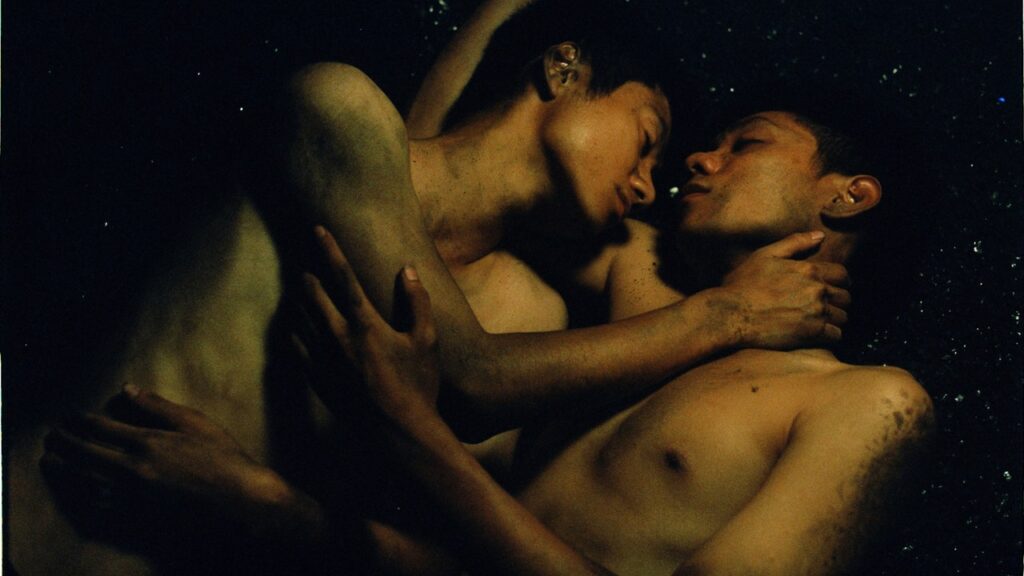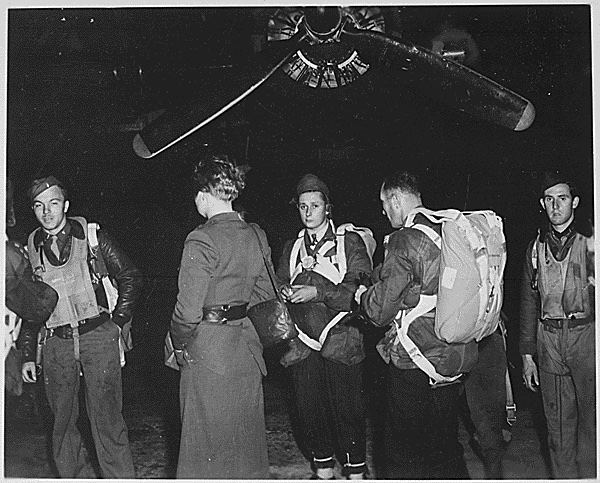Every good film is, to some degree, a transporting experience—a dissolution of boundaries between here and there, then and now. See enough of them, from all over the world, and they begin to feel like the cheapest way to travel. Two of the finest voyages you can take in a theatre right now are themselves saturated in wanderlust. “Việt and Nam,” from the Vietnamese writer and director Truong Minh Quy, ventures from north to south before setting its gaze on dangerous new horizons; “Grand Tour,” from the Portuguese filmmaker Miguel Gomes, is a country-hopping screwball movie. Both, as it happens, commenced their own journeys at the 2024 Cannes Film Festival and arrived, last week, at their U.S. ports of call. Although they could hardly differ more in tone, form, and rhythm—“Grand Tour” is a restlessly kinetic romp, “Việt and Nam” the stateliest of drifters—each is nothing less than an invitation to get thoroughly, blissfully lost.
The title characters in “Việt and Nam” are two gay men, in their twenties, who work as coal miners in a northern Vietnamese village. They spend their days sweating in subterranean caverns, extracting coal and, when they are alone, making love with ecstatic abandon. The most striking image finds Việt (Dao Duy Bao Dinh) and Nam (Pham Thanh Hai) locked in a dirt-caked embrace, their bodies illuminated by the hard shimmer of anthracite. You fear for their safety—even in a small, rural town, there are surely less jagged, more hygienic places for a tryst—but Truong and the cinematographer Son Doan transform this rugged hideaway into a vision of bejewelled splendor. The lovers may be hundreds of feet below the earth’s surface, but, surrounded by countless glinting points of light, they might as well be floating among the stars.
“Việt and Nam” is full of such ravishing reversals: dream sequences that initially, and uncannily, mimic the texture of reality; characters whose identities come into focus only through some strategic repositioning of the camera. Truong, who directed two previous features (“The Tree House,” from 2019, and a documentary, “The City of Mirrors,” from 2016), cultivates an oneiric disorientation, predicated, as the title suggests, on blurry juxtapositions and divisions. Việt and Nam are in love, but not inseparable; Nam, seeking a better life, wants to move abroad. The year is 2001—early on, someone announces that planes have struck the World Trade Center—but, psychologically, the protagonists are mired in an earlier time and in an earlier tragedy.
In a dim, cavelike hut where Nam lives with his mother, Hoa (Nguyen Thi Nga), a TV blares the names of soldiers who were killed during the war, in the nineteen-seventies, but whose remains were never found. Among them is Nam’s father, who, several months before Nam was born, died fighting for the Viet Cong, somewhere in the jungle near the North-South border. Hoa goes to bed each night looking forward to seeing her late husband in her dreams; she even keeps a journal where she writes down what she’s convinced are messages from him concerning the whereabouts of his final resting place. In the hopes of finding it, Việt and Nam travel south with Hoa and a veteran, Ba (Le Viet Tung), who served alongside Nam’s father.
“Việt and Nam” is a series of excavations, and, for all its gentle cadences—a shot of jungle leaves rustling in the wind about approximates the story’s rhythm—it seems to unearth new mysteries and paradoxes by the minute. In the mines, Việt and Nam dig and dig with an intensity that will surely hasten their own deaths; but they also find a refuge where they can experience love and, therefore, life. In their search for Nam’s father, Nam and Hoa enlist the help of a famed psychic who specializes in locating soldiers’ remains. Her theatrics are surely an elaborate hoax, but for many who have spent decades grieving it may not matter. The psychic’s interventions seem to promise, through sheer power of suggestion, a cathartic measure of closure.
But is it enough? The sad, longing look on Hoa’s face, after the psychic relays a communication from her husband, offers little clarity. Nam, for his part, must sift through the remnants of a conflict that ended almost before his life began. In the South, he and his travelling companions visit war museums and memorials; at one point, the group, while digging in a spot that Hoa believes could be her husband’s unmarked grave, uncovers an undetonated bomb. In another film, it might’ve gone off, but, in “Việt and Nam,” the mere discovery is jolting enough. A pursuit for closure unearths the opposite, a reminder that the horrors of war aren’t easily shaken off.
If the weight of the past bears down on Việt and Nam, so does the grim uncertainty of the future. Truong drew inspiration from a 2019 tragedy in which thirty-nine Vietnamese migrants were found dead in a refrigerated truck in the U.K. The film alludes to those events obliquely, with an image of haunting power that I’ll leave you to discover for yourself. Audiences in Vietnam, alas, haven’t had that chance. The Vietnamese Cinema Department has banned the film, citing its “gloomy, deadlocked, and negative view” of the country. This sad and sublimely beautiful movie, however, refuses to bog itself down in pessimism. Việt and Nam’s village is no bastion of queer acceptance, but their relationship has its supporters, Hoa among them, and the men seem to regard the threat of exposure as more of an inconvenience—and, in one scene, a source of unexpected levity—than of alarm. A good thing, too: in a film where the presence of death feels like the heaviest of weights, the pure force of Việt and Nam’s desire is almost enough to keep them going.
To wander from “Việt and Nam” into “Grand Tour” would be a bit like emerging from a cave and immediately hopping aboard a Ferris wheel, a train, then a steamboat, a taxi, a motorcycle, and an aerial tram, only to realize, with a start, that each of these vehicles has been a sort of time machine. Shot mostly in black-and-white, with the occasional splash of color, the film is a gorgeous, freewheeling contraption; it never stops, rarely slows down, and always seems to be headed, dizzyingly, in at least two directions. It’s also thunderously romantic, although the romance here is with the possibilities of the open road. “Việt and Nam” gives us a couple on the brink of separation; “Grand Tour” does the same, but with a sadder (if also funnier) twist: its two leads never appear together.
They are Edward (Gonçalo Waddington), a British civil servant, and Molly (Crista Alfaiate), his fiancée of seven years. No longer wishing to marry Molly, if he ever really did, Edward flees from Mandalay to Rangoon to Singapore to Bangkok to Saigon to Manila to Osaka to Shanghai to Chongqing. Molly follows in dogged pursuit, sending telegrams asking him to wait for her, but Edward, whom she sometimes misses by a matter of minutes, never does. Between Edward’s cold (but quick) feet and Molly’s unflagging tenacity, “Grand Tour,” at times, plays like a live-action Pepé Le Pew cartoon, albeit one in which Edward, the hapless pursuee, is also the stinker. (Gomes, one of four credited co-writers, has claimed an older inspiration, from 1930: “The Gentleman in the Parlour: A Record of a Journey from Rangoon to Haiphong,” a collection of writings by W. Somerset Maugham, about his travels across Southeast Asia.)
“Grand Tour,” by Miguel Gomes.Courtesy of MUBI
The film takes place in 1918—but that isn’t quite right. Can a film really be said to take place in 1918 if nearly half its material constitutes a nonfiction collage of twenty-first-century life? Gomes, who won Cannes’ Best Director prize last year, is a skilled and inveterate trickster whose films, such as “Tabu” (2012) and “Arabian Nights” (2015), delight in blurring formal and temporal boundaries. Gomes’s previous feature, “The Tsugua Diaries” (2021), which he co-directed with Maureen Fazendeiro, was a pandemic-era movie about the making of a pandemic-era movie, and it playfully unfurled its story backward. As it happens, “Grand Tour” is also something of a pandemic-era movie. Gomes and his crew began shooting it in early 2020, gathering footage across Asia on a grand tour of their own; COVID cut things short, and production resumed in 2022. What emerged from the shoot was a rich trove of quotidian snapshots—of boat rides, car treks, markets, a cockfight, a karaoke performance, a mah–jongg game—that subsequently informed, and were eventually grafted onto, Edward and Molly’s story. (The film credits three directors of photography—Rui Poças, Sayombhu Mukdeeprom, and Guo Liang—and two editors, Telmo Churro and Pedro Filipe Marques.)
We are flung, then, into a kind of giddy temporal maelstrom, in which geography is the only constant. Edward and Molly’s moods, thoughts, and decisions are explained in steady snippets of voice-over, but the narrators themselves keep changing—and switching languages—as the characters’ journey continues apace. The film slips between colonial past and post-colonial present with hilarious ease; the camera might follow a feverish Molly into a wilderness, only to emerge in roughly the same spot more than a century later. At one point, Edward flees a dance in Bangkok; after we lose him in a flurry of waltzing bodies, Gomes, caught up in the moment, suddenly deposits us into another plane of elaborately choreographed movement: a modern-day traffic circle in Saigon, full of drivers and motorcyclists.
That whole sequence is set to “The Blue Danube Waltz,” a piece that, after its magisterial showcase in “2001: A Space Odyssey” (1968), may seem useful only for purposes of homage or parody. By running the music at length, though, and with only the gentlest of winks, Gomes all but instructs us to surrender to the exuberant earnestness and grandeur of the moment. Notably, he filmed the 1918 material with Waddington and Alfaiate on soundstages. Making no effort to conceal the creaking obviousness of the sets—the site of a locomotive crash, a veranda overlooking a beautiful garden—Gomes revels in a blatant Old Hollywood artifice. A scene in a hotel restaurant is dotted with old-fashioned iris shots; Molly responds to almost every comment with a gawky spit-laugh, in the vein of a classic screwball heroine.
The contrast between these moments and the present-day footage appears jarring on paper, and not merely owing to the differences between period stylization and documentary realism. The 1918 segments constitute a larky spectacle of antiquated privilege, in which two well-to-do white Europeans hop from country to country, many of them still in the grip of British rule. In contrast, the Asian locals we see in the contemporary footage—Burmese farmers, Thai motorists, Filipino singers, Japanese diners—have little time for such capricious whimsy; some of them regard the camera with a quizzical stare, if they acknowledge its presence at all. Remarkably, though, “Grand Tour” never buckles under the strain, or suggests any strain to begin with. It moves between cities and centuries, and teasingly undermines the relationship between sound and image, with a sly and miraculous fluidity.
Amid such unrestrained play, the mind seizes all the more fiercely onto recurring images. One of the most significant motifs in “Grand Tour” reminds us of the prevalence of puppetry as an art form. In one scene, animal marionettes dance on strings; in another, shadow puppets act out a bawdy folk tale. These moments are stunning in their own right, but they also lay bare the ravishing simplicity of Gomes’s methods. The puppet shows derive their power, in part, from the conspicuous presence of the puppeteers; the more we see of them and their exertions, the more transfixing the illusion. So it is with “Grand Tour,” which, in refusing to hide its formal seams and intricate associations, becomes all the easier to get lost in. If Molly is the more sympathetic of the protagonists, it is nonetheless easy enough to identify with Edward when, asked by a guide if he cares where he’s headed, responds, “I’ll go wherever you take me.” ♦
Premium IPTV Experience with line4k
Experience the ultimate entertainment with our premium IPTV service. Watch your favorite channels, movies, and sports events in stunning 4K quality. Enjoy seamless streaming with zero buffering and access to over 10,000+ channels worldwide.

















